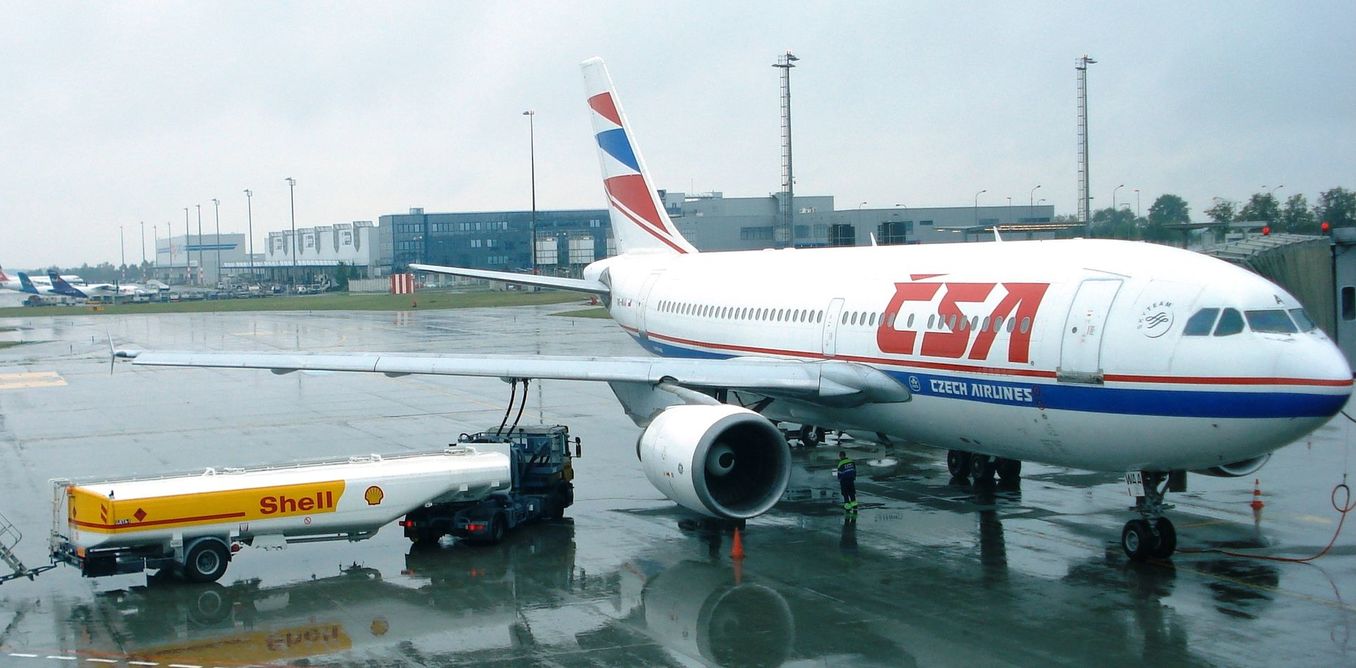When it comes to reducing carbon emissions, one of the biggest hurdles is the world’s addiction to flying. And this is only going to get more intense as developing countries grow bigger middle classes who want to explore the world for business and pleasure.
In the UK, the climate change minister, Nick Hurd, has named transport as one of the two biggest environmental challenges. But while the government continues to invest in research and infrastructure for electric vehicles, clear action on addressing carbon dioxide for air transport has been lacking.
Our researchin collaboration with Manchester Metropolitan University and Missouri University of Science and Technology has shown that greener aviation fuels could cut not only carbon emissions but also reduce wider air pollution and improve air quality – a key issue in the ongoing debate around Heathrow’s proposed expansion.
The landmark 2015 Paris Agreement on addressing climate change did not include two sectors – aviation and maritime. This is despite aviation accounting for 2% of global carbon dioxide emissions. This figure is growing by around 3% a year. Attempts to decarbonise the aviation sector have been complicated.
The process has been delayed by governments trying to agree on how to account for emissions – if a Dutch airline takes off in America and lands in Brazil, which country should take the responsibility for those emissions? The good news is that, in the autumn of 2016, the world’s governments came together under the UN’s specialist agency for aviation, the ICAO and finally reached an agreement. But this agreement is still voluntary and allows airlines to “offset” their carbon emissions.
Beyond this, the industry has set itself a targetto achieve carbon-neutral growth by 2020 and to halve emissions by 2050 compared to 2005 levels. This ambition can only be achieved by a combination of efforts including improvements in engine and airframes, such as new materials to make aircraft lighter, a more emissions-optimised approach to air traffic management and, crucially, by introducing greener alternatives to jet fuel.
These alternative aviation fuels could offer the UK airline industry between 15% and 24% reduction in CO2 emissions by 2050. The UK government is starting to take action, including issuing a consultation on whether to increase the obligation it puts on airlines to increase the level of so-called “renewable fuel” used currently. Running in parallel with this has been a consultation on the future growth of Heathrow airport – and, even in this, alternative fuels could play a part both in terms of lower CO2 emissions if alternative fuel use is increase, and because these fuels contain fewer particulates than conventional fuels.
Our research has shown that particulates from air travel could be reduced by up to 60% by using synthetically produced fuels from feedstocks such as old cooking oil. In simple terms, the oil-baring feedstock can be heated with a catalyst to change its structure and extract the useful chemicals to form a type of fuel that can be used to power jet aircraft.

The Airbus 319 burns 640 gallons of fuel per hour. Nordroden
There are, of course, challenges which need to be overcome if the role of alternative aviation fuels in tackling climate change and air pollution is to be realised.
Aviation fuel has not changed substantially since the 1960s. The focus of improvements in the efficiency of engines and airframes has been on the continued improvements to technology to the point where we have a highly optimised system based on the use of traditional fuels. If the industry adopted fuels developed from non-conventional sources such as bio-crops this may, in turn, make it possible for the indsutry to make further improvements in engine and airframe technologies based on new fuels. There are three major challenges facing the industry.
Three challenges
Safety: This is the most obvious problem to overcome. The approval process for new fuels is extremely rigorous – airlines will not use fuels unless they know they are completely safe and will not affect the operation and reliability of the aircraft. This process can take several years to complete. To date, only a handful of alternative production routes have been approvedand the sector’s experience of dealing with new molecules in the jet fuel is increasing. Better modelling and earlier testing of fuels should help reduce the time, and cost, of this approvals process and efforts such as the US FAA and the ASCENT programme which aim to accelerate the approvals process in the future.
Economics: The technology for producing alternative aviation fuels is still relatively immature and at a small scale which means that the cost remains higher than for fuel from conventional sources. Further research and development – and increasing the scale of production – will address these issues, as will the introduction of regulations which reward and incentivise airlines to use these fuels.
Sustainability: We need to ensure that the production of alternative fuels works for the environment and people in the regions where these are produced. So, for example, in the case of biofuels, these shouldn’t compete for land with vital food crops. The use of municipal waste or offgases from industrial processes are two alternatives which do not compete with land use are gaining some traction as alternative fuels.
This is an issue that will only get more urgent as more people in developing economies choose to travel by air. We’ve already made a good start – since 2011, more than 2,200 commercial flights have used alternative fuels– but this has to be put in a context of more than 100,000 flights being made worldwide each day.
While the current agreement is voluntary, ICAO has managed to create one of the first global agreements to apply to a specific sector on carbon emissions. Industry and academia now need to deliver the advancements – supported, needless to say, by national governments. That will be crucial if we are to see greener skies overhead any time soon.
 Simon Blakey receives funding from the European Union, Innovate UK and Aviation OEMs.
Simon Blakey receives funding from the European Union, Innovate UK and Aviation OEMs.



 Boeing Seeks FAA Emissions Waiver to Continue 777F Freighter Sales Amid Strong Cargo Demand
Boeing Seeks FAA Emissions Waiver to Continue 777F Freighter Sales Amid Strong Cargo Demand  Novo Nordisk Stock Surges After FDA Approves Wegovy Pill for Weight Loss
Novo Nordisk Stock Surges After FDA Approves Wegovy Pill for Weight Loss  AstraZeneca’s LATIFY Phase III Trial of Ceralasertib Misses Primary Endpoint in Lung Cancer Study
AstraZeneca’s LATIFY Phase III Trial of Ceralasertib Misses Primary Endpoint in Lung Cancer Study  Saks Global Weighs Chapter 11 Bankruptcy Amid Debt Pressures and Luxury Retail Slowdown
Saks Global Weighs Chapter 11 Bankruptcy Amid Debt Pressures and Luxury Retail Slowdown  Roche CEO Warns US Drug Price Deals Could Raise Costs of New Medicines in Switzerland
Roche CEO Warns US Drug Price Deals Could Raise Costs of New Medicines in Switzerland  Elon Musk Wins Reinstatement of Historic Tesla Pay Package After Delaware Supreme Court Ruling
Elon Musk Wins Reinstatement of Historic Tesla Pay Package After Delaware Supreme Court Ruling  Robinhood Expands Sports Event Contracts With Player Performance Wagers
Robinhood Expands Sports Event Contracts With Player Performance Wagers  Dina Powell McCormick Resigns From Meta Board After Eight Months, May Take Advisory Role
Dina Powell McCormick Resigns From Meta Board After Eight Months, May Take Advisory Role 
































